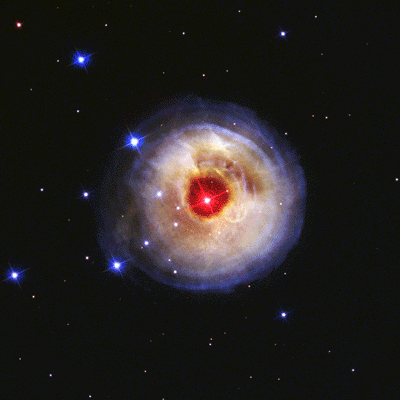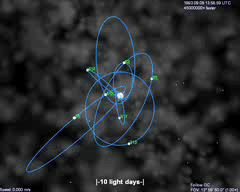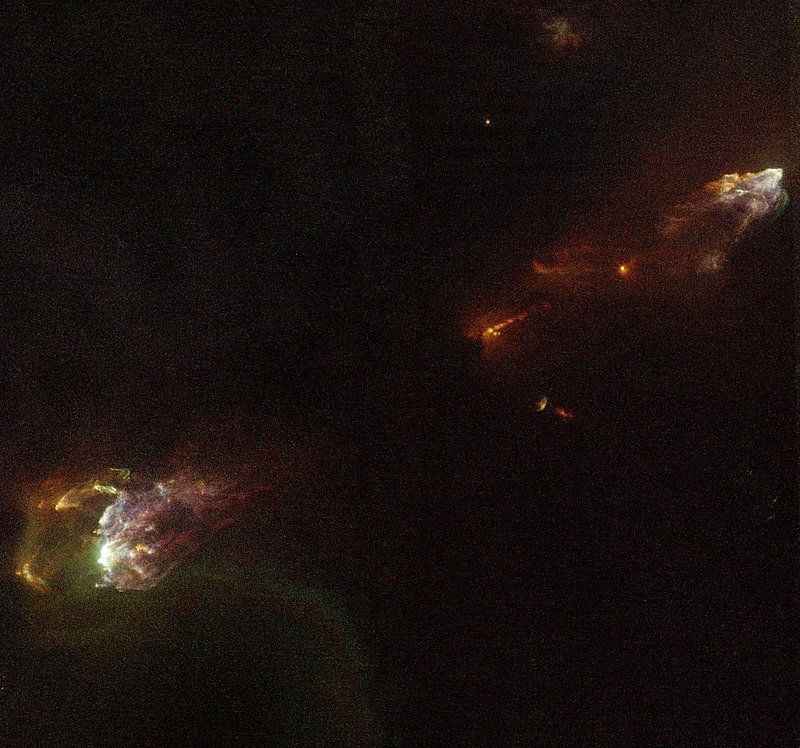Things that move visibly in deep space
Until recent decades, the only things that changed visibly within a human lifetime outside our solar system were supernovae, and the apparent positions of nearby stars (and that only barely measurably).
Modern equipment has uncovered many objects of several kinds that change visibly in human time-scales. Here are a few examples.
Still, the only things that change outside our galaxy in human lifetimes are supernovae (well, and cepheid variable stars…).
I started this list in the mid-2000s. For some years I was trying to keep up with new examples, but nowadays, I’m afraid, new discoveries are coming too fast for me to keep up with.
stellar explosions
Eta Carinae explosion debris
Eta Carinae is the largest star known in our galaxy, being some 120 to 220 times as massive as our Sun, with a companion star that is 30 to 80 times as massive as our Sun orbiting it every 5½ years. Beyond that, it is hard to make direct observations, because material that has recently been ejected from the system obscures the stars. It formed only a few millions of years ago, and hasn’t long to live, as stars go.
The bell-shaped object is the remains of an outburst of the star that occured in 1827. It still changes visibly within months.
Unfortunately not a video, but a “difference of two images taken 17 months apart”

supernova SN 1987A
In 1987, the first relatively-nearby supernova of recent times appeared. It was not in our galaxy, but in its satellite, the Large Magellanic Cloud. After the flash of the explosion, that lasted several days, some strange patterns appeared in the environs of the star.
One guess is that these bead-like effects are supernova debris crashing into surrounding gases, probably thrown off by preceding outbursts from the star.
Crab nebula change over time
The crab nebula appears to correspond to a supernova that appeared in 1054 AD. Its remains are still expanding at about 5% the speed of light.
Original at APOD 2023 March 20, this is a sequece of photographs made with the same equipment over a span of 14 years.
light echos
light echo from star V838 Monocerotis
This is light from a flash made by the star, reflected off dust and gas in the vicinity of the star, moving between successive observations. So, this isn’t material moving, it is light moving through material.

light echo of pulses from the Cepheid variable star RS Pup
The star pulses every 40 days or so, waves of light from those pulses pass through surrounding dust and echo back to us.
See: Light echoes whisper the distance to a star
black hole dynamics
black hole Sgr A* at center of Milky Way galaxy
Our local big black hole, weighing in at around 3 million solar masses, are not visible wavelengths of light, but has a very big effect on surrounding stars.
These are big stars, behaving like comets orbiting the black hole. But some are in very fast orbits, with periods of 11 years or so, although their orbital radii are several times that of our solar system.

Main site at Max-Planck-Institut für extraterrestrische Physik, with further animations
neutron star jets
Crab nebula neutron star disk and jet in X-ray
By the Chandra X-ray observatory: it looks like an artist’s rendition of a hypothetical accretion disk and jet, but it is an actual observation.
There is an apparent shock wave, apparently in a disk-like structure, punctured by a jet. The disk is far too large to be an accretion disk. I don’t know what it is.
The jet is clearly moving. In the accretion disk, the motion is that of shock waves moving through the disk.
Radio Telescope video: Scorpius X-1
Scorpius X-1 was the first discovered extraterrestrial X-ray source. It is relatively nearby (9000 light years distant), and seems to consist of a medium-sized star and a neutron star orbiting one another every 19 hours. The neutron star would then strip material off its companion, which would accrete to its surface, periodically producing an accretion disk and jet.
The jet consists of two beams, one pointed toward us, one away. Here we see a clump in the lobe pointed at us, moving very rapidly—at nearly the speed of light.
From our vantage point, the size of the source and the lobes is very small. These pictures were made using numerous radio telescopes; only such equipment could resolve these small details.

jets from young stars
Accretion disks and gas jets are a common of occurrence in several rather different situations. Besides the big jets associated with distant black holes (where the disk is too small to be visible) and some neutron stars, young stars nearby us also sport small jets.
HH 1

A video of the central region: